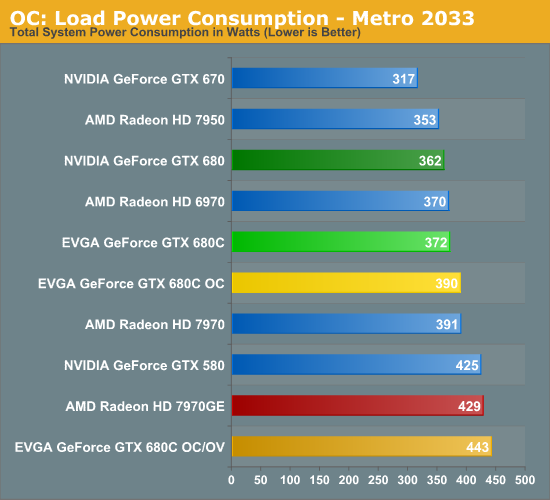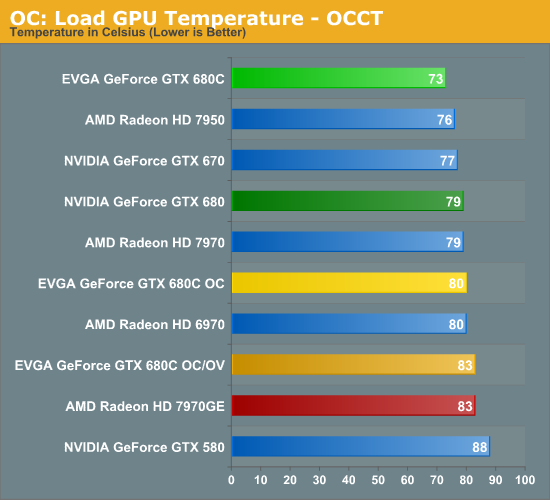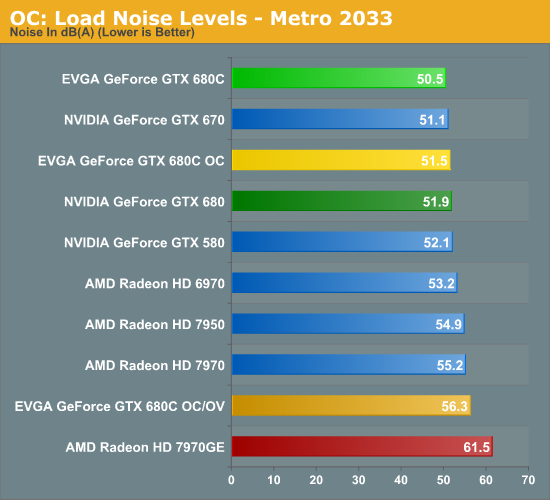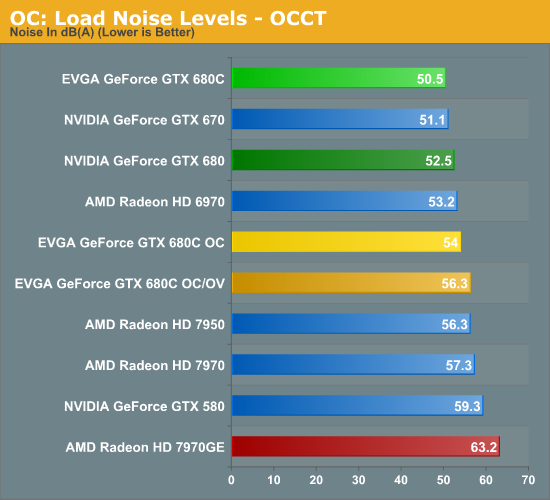EVGA GeForce GTX 680 Classified Review: Pushing GTX 680 To Its Peak
by Ryan Smith on July 20, 2012 12:00 PM ESTOverclocked: Power, Temperature, & Noise
So far our look at the stock performance of the GTX 680 Classified has been more obligatory than critical. The GTX 680 Classified is first and foremost an overclocking card, and while EVGA ships it with a decent factory overclock it’s the end-user overclock that is going to make the GTX 680 Classified stand apart from the crowd.
So how did the GTX 680 Classified fare? As always, we’re going to break our results down into two categories. We’ve overclocked our sample both with and without overvolting it, to get an idea of just how much more headroom is left in the GK104 GPU at stock, and how much more headroom is unlocked through overvolting.
| EVGA GTX 680 Classified Overclocking | |||||
| Stock | OC | OC + OV | |||
| Core Clock | 1111MHz | 1211MHz | 1287MHz | ||
| Max Boost Clock | 1201MHz | 1301MHz | 1377MHz | ||
| Memory Clock | 6GHz | 6.4GHz | 6.5GHz | ||
| Max Boost Voltage | 1.175v | 1.175v | 1.275v | ||
Without overvolting we were able to push our GTX 680 Classified an additional 100MHz(9%) on the core to 1211MHz. Given that we started with what was already a factory overclocked GPU, the fact that this is nearly 100Mhz beyond our next best card should come as no surprise. Binning doesn’t just isolate GPUs that can reach EVGA’s stock specifications, but it isolates those GPUs that can overclock better than the rest too.
Meanwhile on the memory front we were only able to push the memory a further 400MHz to 6.4GHz. This is noticeably less than what we’ve been able to push reference-based GTX 670/680 cards (which have reached nearly 7GHz), and it’s not immediately clear why we’re seeing this difference. With both a custom PCB and additional memory chips it’s possible that either one could be holding back memory overclocking, or more likely it’s a combination of the two. Regardless of the reason this does put the GTX 680 Classified in a bit of a bind, since the GTX 680 is no stranger to memory bandwidth starvation.
As for the impact of overvolting, unfortunately as it turns out overvolting didn’t greatly improve our results. With a core voltage of 1.275v (0.1v over stock) we were able to hit a base clock of 1286MHz, which is just 75MHz higher than what we hit on the stock voltage of 1.175v. In fact both in absolute and relative terms we gained more from our initial stock voltage overclock than we did from the overvolting overclock. Which is not to say that overvolting doesn’t help – clearly it does – but in our limited experience overvolting isn’t unlocking any kind of amazing clockspeed. It’s merely pushing GK104 a bit higher than it can go on stock voltage.
Memory overvolting doesn’t have a particularly great impact either. With a memory voltage of 1.65v we were able to squeeze out another 100MHz with the GTX 680 Classified’s 4GB of GDDR5. Much like the core overclock this is an improvement, but not greatly so.
Ultimately overvolting the GTX 680 Classified most certainly improves its overclockability, but at least on air you won’t be hitting any obscene clocks. Even then we don’t seem to be particularly temperature limited, so it’s not clear whether better (but not extreme) cooling would improve our overclocking results.
But before we jump into our results, there’s one more thing to take into consideration: that pesky power target. EVGA does have a higher power target, but even at 300W+ when using an increased power target, overvolting is going to quickly vault you towards it. The end result is that too much overvolting can make things slower, or at the very least limit the performance gains of what’s already a limited clockspeed increase.
The solution to this is EVGA’s BIOS switch, which effectively removes all of the power limits for the card, but this is not something to be used carelessly. Based on our temperature results with the stock BIOS there’s still some headroom, but the fact that this switch is labeled “LN2” is telling. Disabling all of the power limits is probably not a good idea on the reference cooler, at least in our conservative opinion.
So now that we’ve gone over overclocking in detail, what has it done for power temperature and noise? Let’s find out.


Starting as always with power consumption, as to be expected the impact of overclocking on power consumption varies wildly with whether we’re overvolting. Without overvolting our overclock pushes power consumption at the wall up by 18W in Metro, and a much more significant 49W with OCCT (though do keep in mind that we’ve also raised our power target to +132%). At least as far as games go, without a voltage increase the overall increase in power consumption is fairly small.
Pouring on the voltage significantly increases the power consumption however in both Metro and OCCT. With Metro our power consumption is now 443W at the wall, and with OCCT that’s 425W. This isn’t to say that the overvolting wasn’t worth it, but that additional 75MHz on the core clock and 100MHz memory clock has come with a significant cost.


As to be expected, load temperatures end up reflecting our power consumption figures. Without overvolting we see a 1C increase under Metro and a 7C increase under OCCT. Overvolting pushes the GTX 680 Classified over 80C in all circumstances, topping out at 83C with OCCT. At only 83C there’s still some thermal headroom to play with here for overclocking, but at 1.275v we’re approaching the safe & sane limits for GK104. Users looking to push the voltage harder will want better cooling, but even better cooling may not be enough in the long-run.


Finally we have our look at load noise. Without overvolting we see the overclocked GTX 680 Classified hit 51.5dB, which incredibly enough is still a smidge quieter than the reference GTX 680. For those of you looking for a fairly quiet overclocking card, the GTX 680 Classified is starting to look very good.
As for overvolting, in both Metro and OCCT cause our sample card to hit 56.3dB. This is understandably louder than the reference GTX 680 at this point, though in absolute terms whether it’s particularly loud or not depends on what you’re willing to put up with. The consolation prize here is that even with overclocking and overvolting it’s still 5dB+ quieter than the reference 7970GE.










75 Comments
View All Comments
SteveLord - Friday, July 20, 2012 - link
I too have been waiting on a mid range offering. This is crap nVidia.......RussianSensation - Saturday, July 21, 2012 - link
What's wrong with HD7850 for $200-210 or MSI TwinFrozr HD7950 $310, both with 30-40% overclocking headroom? HD7950 @ 1.1ghz > GTX680. No point in waiting for this mythical GTX660Ti.CeriseCogburn - Tuesday, July 24, 2012 - link
You have the mythical $200 or $210 7850 that bottom price is running anyone $220 for the crappiest version around.Why do you people always talk lies ?
HisDivineOrder - Friday, July 20, 2012 - link
nVidia will launch the 660 part on the day the entire Radeon 8xxx series shows up. On the very day.I know I've waited forever and a day for it, too. I've given up hope. I think it's a myth at this point. A story grandpappies tell their youngin's. A tall tale.
The Geforce 660 is a legend wrapped in a mystery drizzled with lies and peppered with vague promise.
RussianSensation - Saturday, July 21, 2012 - link
Rumor: August 16th for 660 series.CeriseCogburn - Tuesday, July 24, 2012 - link
What does midrange mean to you ? The 460 560 560ti 570 580 have "midrange" covered... unless of course you mean non mid mid range, or middler lwor midrange, or range of ranges unranged of which there are none....WHAT are you people expecting ? What cards exactly is this mythical purportedly missing midrange supposed to fall in between for you ?
I'm serious, it's been many, many months, but by logic alone, there isn't a card spot you so desire, and by absolute omission for just as long....
What the freak do you people expect ? The only thing I can possibly imagine is a "midrange card" that falls above the 580, above the 7870, above the 6970, below a stock 670... and costs perhaps "$150=$200" for your "midrange budget" - right ?
I don't get it. Won't one of you midrange wannabes explain it - sometime before it appears, or like is the fantasy supposed to be an absolute mystery forever ?
Galidou - Sunday, August 5, 2012 - link
What do we expect?? Mid range prices with last gen top of the line performance but new gen power consumption and temperatures.... Seems pretty clear to me. Ok you need an example... gtx 560ti between gtx470-480 performance but less power and lower temperatures so I don't have to change power supply if I go sli nor change my case, in the end, save some money and game as well + overclock better.Everything that came out from nvidia from THIS very generation is overkill for gaming at 1080p, and that's the most used resolution in the whole freaking world, end of the discussion... who do you beleive you are criticizing everyone's desire/needs? GOD?
CeriseCogburn - Saturday, August 25, 2012 - link
Ok, well thanks for trying.However, nothing is overkill for 1080P, they ALL have to be turned down except the TOP duals.
So a 680 and 7970 are underkill for 1920 1200 + 1920 x 1080.
Belard - Saturday, July 21, 2012 - link
Remember when the 4850 first came out as a $250 card... yet eventually ended up as a $100 card. Even todays modern $100 video cards are not much faster than the 4850... and that card is over 4 years old!If we go by the usual scale of GPU performance increases at targeted price points...
For today, we should be able to get the performance of a 5870 card at a $100 price.
What do we have? The 6870 is slightly slower than the 5870 (great model naming there AMD - idiots), it costs about $155. (okay, the 5870 was a $500 card).
The smaller and cheaper to make 7850 is slightly faster than the 5870, but it costs about $225?! The 6870 is a better deal since its $75 cheaper yet about 7% slower.
So realistically, the $130 7770 is over-priced as its 2/3rd the performance for a $20~30 savings over the older 6870.
Of course, the 5770/ 6770 and 7770 are all pretty much the same card... not impressive.
RussianSensation - Saturday, July 21, 2012 - link
MSRP for the HD4850 was $199, HD4870 was $299. HD4850 was never $250.I agree with you that most of the performance increase in GPUs has happened in the $250+ level. Although HD7850 OCed = GTX580. The 7850 can be found for $200-230 no problem and GTX580 cost $500 just 1.5 years ago. So it is progress, just not as fast as in the past.
It's too expensive to make fast GPUs in the ~ $100 level. If you can only afford $100-130 GPUs, I think you are better off just getting a PS4 or the next Xbox. The allure of the PC are the games you can't play on consoles, controls, mods and better graphics and much cheaper game prices. $300 for a GPU isn't expensive when you consider the prices of games on the PC.
But ya I agree with you that HD7750/7770 are a joke. The latter is just 25-30% fater than a 2.5 year old HD5770. NV has nothing for less than <$400 (GTX670) worth buying. I guess that's what happens when wafer prices rise and the market for <$100 GPUs disappears.